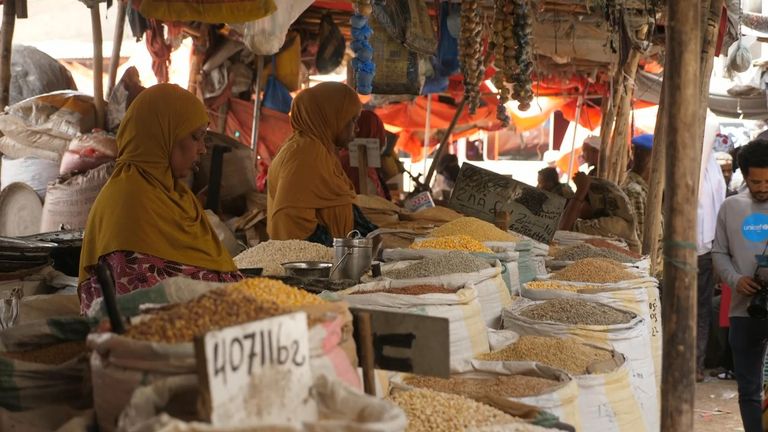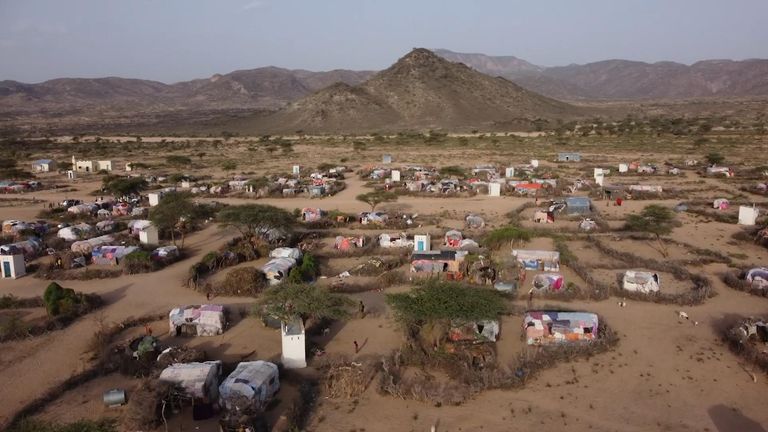https://www.ft.com/content/081ac952-48a0-4f67-a597-16b4a98921ba
Horn of Africa ravaged by worst drought in four decades
Up to 20mn people could go hungry as delayed rains exacerbate fallout from war in Ukraine

When the last of his 250 goats died, pastoralist Abdullahi Abdi Wali knew it was time to flee what he calls the “worst drought” in his 99 years of life. “This is the first time I was displaced by a drought,” he said, looking back on his near-century in south-eastern Ethiopia. After the death of his animals, Wali walked for five days under a scorching sun to reach a makeshift camp hosting 10,000 Ethiopian pastoralists outside the city of Gode, where they now receive food and water. In the Horn of Africa as a whole, in an area stretching from northern Kenya to Somalia and swaths of Ethiopia, up to 20mn people could go hungry this year as delayed rains exacerbate what was already the worst drought in four decades. After three consecutive rainy seasons failed and a fourth looks likely to do the same, crops have disappeared and more than a million livestock have died in Ethiopia’s south-eastern Somali region alone. One more dry season could turn what is already a disaster into the worst drought in a century, locals say — just as the region is braced for what could be the devastating fallout of war in Ukraine. The conflict threatens not only to increase food prices but also to push the cost of fertiliser beyond the means of millions of farmers, threatening next year’s harvest.
Globally, we are facing a year of unprecedented needs as conflict, climate shocks and the rising costs of food and fuel leave millions in need of humanitarian assistance,” said Michael Dunford, World Food Programme regional director for eastern Africa. As temperatures rise globally, food security in the arid and semi-arid parts of the Horn are becoming evermore precarious, experts say. Although droughts are not new, they are becoming more frequent and severe. Since 2008, the area has registered a drought almost every year. In 2011, a famine in Somalia is thought to have killed a quarter of a million people.
Horn of Africa ravaged by worst drought in four decades
Up to 20mn people could go hungry as delayed rains exacerbate fallout from war in Ukraine
Horn of Africa ravaged by worst drought in four decades
Up to 20mn people could go hungry as delayed rains exacerbate fallout from war in Ukraine
Somalia drought map Temperatures in parts of the Horn of Africa have scaled record highs. Over the past four decades, rainfall averages have continued to decline, with shorter and shorter rainy seasons. Now the situation is so severe that local elders in villages in Ethiopia’s Somali region recount stories of half-starved hyenas, monkeys and warthogs attacking under nourished children for food. “We had to move the children to the city to protect them,” said Mohamed Dagane Digabe, a clan elder in the village of Gabia, almost 30km from Gode.
But for many, there may be nowhere to run.
“It is regional so options for migrating to neighbouring areas are not there,” Mustafa Mohamed Omar, president of Ethiopia’s Somali region, told the Financial Times. “Somalia is affected, Kenya is affected, parts of Oromia in Ethiopia are affected. We are sure such a drought is unseen in almost 50 years; people are even saying 100 years.” The WFP is warning of outright famine in Somalia, where some 6mn people, or 40 per cent of the population, are facing acute food insecurity in a country where jihadi violence is rife. Some analysts say more people are fleeing hunger in the country than violence. In Ethiopia, which is reeling from a brutal civil war in the northernmost region of Tigray — a conflict that had already left 9mn people food insecure there and in nearby regions Amhara and Afar — an additional 7mn people now wake up hungry every day in the south and south-east regions, mainly Somali, according to the WFP. Even in relatively prosperous and stable Kenya, the number of people in need of assistance has risen more than fourfold in less than two years, with drought leaving over 3mn acutely food insecure. “The unpredictable rain for semi-nomadic pastoralism, which supports most people in northern Kenya, makes this increasingly unsustainable,” warned Murithi Mutiga, Africa programme director at Crisis Group in Nairobi. “This will be a huge contributor to instability.” At a ward dedicated to malnourished children at the general hospital in Gode, where doctors are tending to two-year-olds who weigh half what they should, Mohamed Abdi Kassa, the medical director, said: “We are expecting more malnourished patients because the drought is not stopping.”
Dunford said: “There is absolutely a crisis unfolding before our eyes across drought-affected parts of the Horn of Africa. In Somalia there is a very real risk that we may see a famine in the coming months if we don’t have rains.” Without adequate funding, he added, humanitarian agencies would not be able to respond if the crisis spread. “People are going to die. It’s as simple as that.” Over the next six months, the WFP alone estimates it needs more than $470mn to scale up assistance across the three countries. But after the economic cost of Covid, donors — distracted by the war in Ukraine — were unlikely to stump up sufficient funds, experts said. “Nobody’s got any money,” said one diplomat. Aid agencies are running low on crucial wheat stocks from Ukraine and Russia, two of the world’s top producers. In Ethiopia, the WFP and the government procure about three-quarters of the wheat they distribute from those two countries. Wheat prices from the Black Sea have jumped 67 per cent since last year, mainly due to Russia’s invasion of its neighbour.
Things will get worse, largely because attention is now focused on bigger emergencies in Ukraine and conflict in the north of Ethiopia . . . resources are also going there and food prices are also rising globally,” added Omar. Halima Mohamed Abdi, a mother of eight who recently settled in another camp outside Gode, is anxious about what lies ahead. “During previous droughts, if we lost the sheep, goats and cows, the camels would survive,” she said. This time, even camels, which generally endure droughts, are dropping dead. “We are expecting support from government and aid agencies because, even if it rains, we have nothing left,” she said. “Without help, we would also die of thirst and hunger.”
The ward for severely malnourished children was full. They were putting patients on mattresses on the floor.
One-year-old Mohamed was having a nasal drip inserted to make sure he gets vitally needed fluids.
On the bed above him another boy, also named Mohamed, was being examined. Just two months old, he was born two months premature. He is his 17-year-old mother’s second son.
She travelled 400 miles to bring him to hospital and did not think he would make it.
The ward’s patients in Hargeisa, the capital of the self-declared republic of Somaliland, are all victims of the region’s worst drought in more than a generation.
The rains have failed for four years now. Ward doctor Dr Abdul Rahman Abdulahi told Sky News he fears for the immediate future.
“If the rains don’t come quickly the situation will become worse day by day and the number of patients will be increasing even hour by hour and day by day and we cannot handle it or we cannot save them.”
Right across the Horn of Africa they are bracing themselves for the double impact of war and famine.

Image:Dr Abdul Rahman Abdulahi says ‘if the rains don’t come quickly the situation will become worse day by day’
The worst drought in 40 years is combining with the impact of Russia’s invasion of Ukraine. The war there may be thousands of miles away but it’s pushing up the prices of grain and fuel to unprecedented levels.
Somaliland and Somalia in general receive 90% of their grain imports from Russia and Ukraine, which is now reduced to a trickle.
Russia and Ukraine account for nearly a third of global wheat supplies. But Ukrainian grain shipments from its Black Sea ports have stalled since Russia invaded, with around 20 million tonnes of grain stuck.
In the market in Hargeisa, the capital of Somaliland, grain sellers all told us the same story. The price has shot up by 75% in three months.

Image:The price of grain in Somaliland has shot up by 75% in three months
As if that is not disastrous enough, the price of fuel has almost doubled, making it more expensive to get grain to those who need it.
In the world’s second poorest country, water comes to most people by trucks filling tanks on the street. Water is more scarce in the drought but much more expensive too because of the cost of fuel, up by 60%.
The impact of the drought has been made much, much worse by a war happening thousands of miles away.
The drought now threatens the worst famine in years. Camps are already filling with people who’ve lost any means of supporting their families. The parents are desperate.

Image:Sophia was a well-off keeper of livestock but has lost everything
We met Sophia, who was a well-off keeper of livestock. She’s now destitute and living in a makeshift tent in Mandera camp halfway across Somaliland after the drought killed all her livestock.
“My grandfather was a goatherd,” she told Sky News. “My father was a goatherd, I grew up in that life and ended up with 500 goats and four camels and they’ve all been wiped out, I’ve got nothing now.”
In the background, they were using long sticks to pull branches and leaves from the trees to feed the goats with no grass left to eat.

But getting food to the people who need it will be a huge challenge.
Across the region, millions are facing acute hunger in the worst drought in over a generation compounded by the war in Ukraine.
And without international help, agencies say hundreds of thousands will die of starvation.
“If we don’t act now, we will see an avalanche of child deaths in a matter of weeks, famine is just around the corner,” Mohamed Fall, the east and southern Africa regional director at UNICEF, said.
The situation is a little bit better in Somaliland thanks to the rains in June and July. But the long dry season is just starting.
The situation will get very much worse from here. The Somaliland Government should start mobilising the drought response now so it has enough fodder and water tankers available.



















